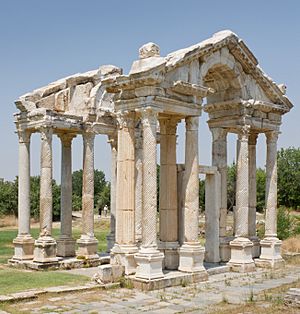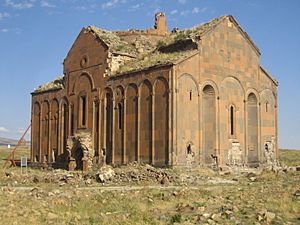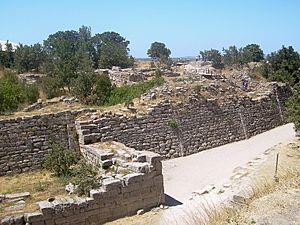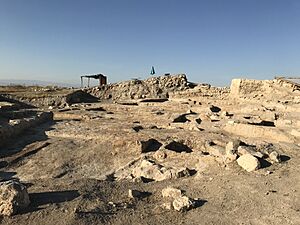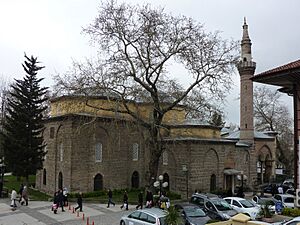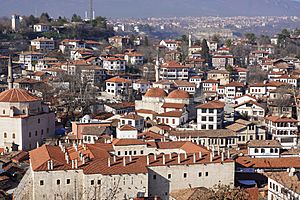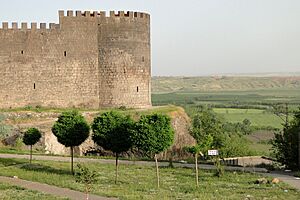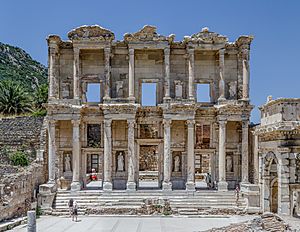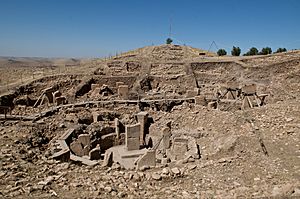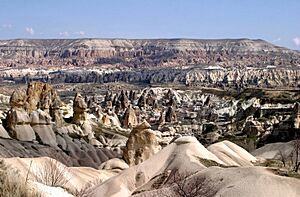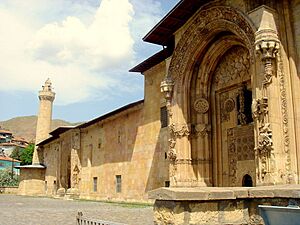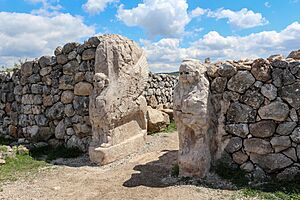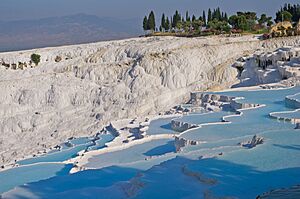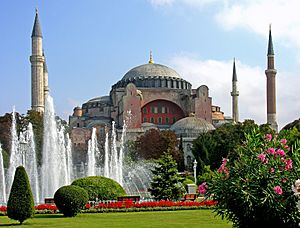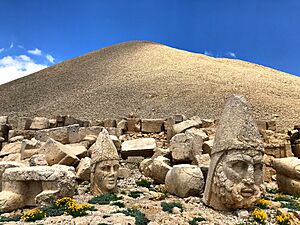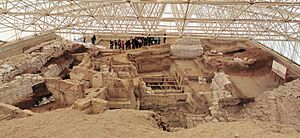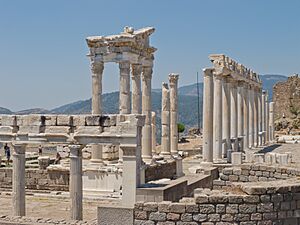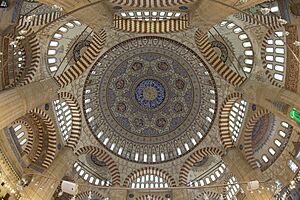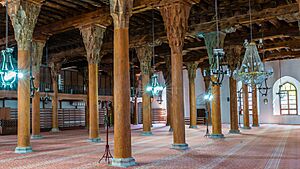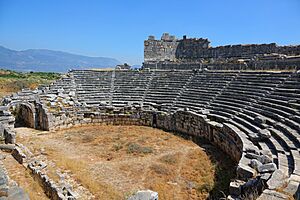List of World Heritage Sites in Turkey facts for kids
The United Nations Educational, Scientific and Cultural Organization (UNESCO) helps protect important places around the world. These places are called World Heritage Sites. They can be important for their culture or nature. UNESCO started this program in 1972.
Turkey joined the program on March 16, 1983. This made its historical sites able to be added to the list. As of 2023, Turkey has twenty-one World Heritage Sites. Most of them are cultural sites, and two are a mix of culture and nature.
The first three sites in Turkey were added in 1985. These were the Great Mosque and Hospital of Divriği, the Historic Areas of Istanbul, and Göreme National Park and the Rock Sites of Cappadocia. The newest sites, added in 2023, are Gordion and the Wooden Hypostyle Mosques of Medieval Anatolia.
Discover Turkey's World Heritage Sites
This table shows you all the amazing World Heritage Sites in Turkey. You can learn about their history and why they are so special.
| Site Name | Image | Location | Type of Site | Area (hectares) | Year Added | What Makes it Special |
|---|---|---|---|---|---|---|
| Aphrodisias | Aydın Province | Cultural | 152 | 2017 | This site includes the ancient city of Aphrodisias. It has a 3rd-century BCE Temple of Aphrodite. Nearby marble quarries helped the city become very rich. | |
| Archaeological Site of Ani | Kars Province | Cultural | 251 | 2016 | Ani is a medieval city near the Turkey-Armenia border. It was the capital of Bagratid Armenia in the 10th and 11th centuries. The city declined after a Mongol invasion and a big earthquake. | |
| Archaeological Site of Troy | Çanakkale Province | Cultural | 158 | 1998 | Troy is over 4,000 years old. It inspired famous stories like Homer's Iliad. It was found again in the late 1800s and is now a very famous archaeological site. | |
| Arslantepe Mound | Malatya Province | Cultural | 74.07 | 2021 | Arslantepe was an ancient city by the Tohma River. It is known for having some of the first swords from the Early Bronze Age (around 33rd to 31st centuries BCE). | |
| Bursa and Cumalıkızık: The Birth of the Ottoman Empire | Bursa Province | Cultural | 27 | 2014 | Bursa was the first capital of the Ottoman Empire in the 14th century. Its city planning was very new and influenced other Ottoman cities. Cumalıkızık is a nearby village that supported the capital. | |
| City of Safranbolu | Karabük Province | Cultural | 193 | 1994 | Safranbolu was a busy trading stop for caravans from the 13th century onwards. Its unique buildings greatly influenced city design across the Ottoman Empire. | |
| Diyarbakır Fortress and Hevsel Gardens Cultural Landscape | Diyarbakır Province | Cultural | 521 | 2015 | Diyarbakır has been an important city for a very long time. This site includes its long city walls (5.8 km) and the Hevsel Gardens. These gardens provided food and water for the city. | |
| Ephesus | İzmir Province | Cultural | 663 | 2015 | The ancient Greek city of Ephesus was famous for the Temple of Artemis, one of the Seven Wonders of the Ancient World. After becoming Roman, it grew with huge buildings like the Library of Celsus. It also became a major Christian pilgrimage site. | |
| Gordion | Ankara Province | Cultural | 1,064 | 2023 | Gordion was the capital city of ancient Phrygia. People lived here from about 2300 BCE until the 4th century CE. It was also inhabited again in the 13th and 14th centuries CE. | |
| Göbekli Tepe | Şanlıurfa Province | Cultural | 126 | 2018 | This site dates back to 10,000-9,000 BCE, making it very old. It was likely used by hunter-gatherers for special ceremonies and rituals. | |
| Göreme National Park and the Rock Sites of Cappadocia | Nevşehir Province | Mixed | 9884 | 1985 | The Göreme Valley is famous for its amazing rock formations, often called "fairy chimneys." The region also has many homes, villages, and churches carved into the rocks. These show great examples of Byzantine art. | |
| Great Mosque and Hospital of Divriği | Sivas Province | Cultural | 2016 | 1985 | Built in the early 13th century, this mosque and hospital complex in Divriği is a unique example of Islamic architecture. It mixes different and interesting designs. | |
| Hattusha: The Hittite Capital | Çorum Province | Cultural | 268 | 1986 | Hattusha was the capital of the Hittite Empire. It has well-preserved city gates, temples, and palaces. The nearby rock sanctuary of Yazılıkaya is also part of the site. | |
| Hierapolis-Pamukkale | Denizli Province | Mixed | 1077 | 1988 | Pamukkale is famous for its beautiful white terraces and petrified waterfalls. The nearby town of Hierapolis was founded in the late 2nd century BCE. It has many Greco-Roman buildings and early Christian art. | |
| Historic Areas of Istanbul | Istanbul Province | Cultural | 678 | 1985 | Istanbul was the capital of the Byzantine and Ottoman empires. It has been a major center for over 2,000 years. Its famous buildings include the Hippodrome of Constantinople, Hagia Sophia, the Süleymaniye Mosque, and the Topkapı Palace. | |
| Nemrut Dağ | Adıyaman Province | Cultural | 11 | 1987 | Nemrut Dağ is where King Antiochus I built his temple-tomb. It is surrounded by huge statues and stone slabs. This was one of the most ambitious building projects of its time. | |
| Neolithic Site of Çatalhöyük | Konya Province | Cultural | 37 | 2012 | This large site was lived in between about 7400 BC and 5200 BC. It is a well-preserved example of an early settlement. Its houses were entered from the roof, and it has ancient wall paintings. | |
| Pergamon and its Multi-Layered Cultural Landscape | İzmir Province | Cultural | 333 | 2014 | Pergamon was founded in the 3rd century BC. It was the capital of the Hellenistic Attalid dynasty and a very important ancient city. Later, under Roman rule, it became a major healing center. | |
| Selimiye Mosque and its Social Complex | Edirne Province | Cultural | 3 | 2011 | Built in the 16th century, the Selimiye Mosque in Edirne is considered the masterpiece of architect Mimar Sinan. It shows the highest level of Ottoman architecture. | |
| Wooden Hypostyle Mosques of Medieval Anatolia | Countrywide | Cultural | 0.61 | 2023 | This site includes five special mosques in Anatolia. They were built between the late 13th and mid-14th centuries. What makes them unique is their wooden columns supporting the roof. | |
| Xanthos-Letoon | Antalya and Muğla Provinces | Cultural | 126 | 1988 | This site has two nearby ancient settlements. Xanthos was the center of the Lycian civilization. Its buildings, like the Nereid Monument, influenced other cities. Letoon was a religious center. It had a stone with writing in three languages, which helped people understand the ancient Lycian language. |
More to Explore
- List of World Heritage Sites in Turkey (tentative list)
- List of ancient settlements in Turkey
See also
 In Spanish: Anexo:Patrimonio de la Humanidad en Turquía para niños
In Spanish: Anexo:Patrimonio de la Humanidad en Turquía para niños


